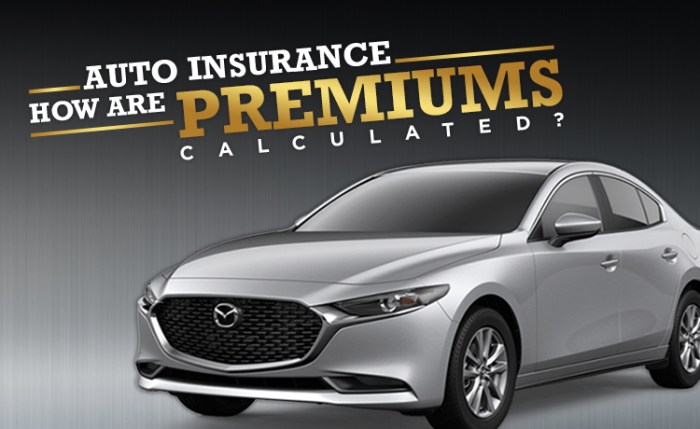Navigating the world of auto insurance can feel like deciphering a complex code. Understanding how auto insurance premiums are calculated is crucial for securing affordable and adequate coverage. This guide unravels the mysteries behind those premiums, exploring the numerous factors that influence their cost, from your driving history and vehicle type to your location and chosen coverage level. We’ll equip you with the knowledge to make informed decisions and potentially save money on your insurance.
From identifying discounts and negotiating lower rates to understanding your policy and comparing providers, we aim to provide a clear and concise overview of the entire process. We’ll delve into the intricacies of risk assessment, the impact of driving habits, and the benefits of various insurance packages, empowering you to take control of your auto insurance costs.
Factors Influencing Auto Insurance Premiums

Auto insurance premiums are not a one-size-fits-all proposition. Several factors contribute to the final cost, impacting how much you pay each month or year. Understanding these factors can help you make informed decisions about your coverage and potentially save money.
Age and Driving History
Your age significantly impacts your premium. Younger drivers, particularly those under 25, generally pay higher premiums due to statistically higher accident rates. Insurance companies view them as higher risk. Conversely, older drivers, particularly those in their 50s and 60s, often receive lower rates, reflecting their generally more experienced and cautious driving habits. Your driving history plays a crucial role as well. Accidents, speeding tickets, and other moving violations will increase your premiums, as they indicate a higher likelihood of future claims. A clean driving record, on the other hand, can lead to significant discounts. For example, a driver with multiple speeding tickets in the past three years will likely pay substantially more than a driver with a spotless record.
Vehicle Features
The type of car you drive is a major factor. Safety features like anti-lock brakes (ABS), electronic stability control (ESC), and airbags significantly influence premiums. Cars equipped with these features are considered safer and therefore less likely to be involved in accidents, resulting in lower premiums. Conversely, vehicles with a history of theft or a high repair cost will lead to higher premiums. For example, a high-performance sports car will generally cost more to insure than a compact sedan due to its higher repair costs and increased risk of accidents. Features like advanced driver-assistance systems (ADAS), such as lane departure warnings or automatic emergency braking, can also lead to lower premiums as they actively help prevent accidents.
Coverage Levels
Different coverage levels correspond to different premium costs. Liability coverage, which pays for damages to others if you cause an accident, is typically the most basic and least expensive. Collision coverage, which covers damage to your vehicle in an accident regardless of fault, is more expensive. Comprehensive coverage, which protects against damage from events other than collisions (e.g., theft, vandalism, hail), adds to the cost further. Choosing a higher deductible (the amount you pay out-of-pocket before your insurance kicks in) will generally lower your premium, but you’ll pay more if you need to file a claim. A balance between coverage level and affordability is key.
Location
Where you live significantly impacts your insurance rates. Areas with high crime rates, frequent accidents, or higher repair costs tend to have higher insurance premiums. Urban areas generally have higher rates than rural areas due to increased traffic density and the higher likelihood of accidents and theft. Insurance companies use sophisticated actuarial models to assess risk based on location-specific data. For instance, a driver in a large city with a high crime rate will likely pay more than a driver in a small, quiet town.
Vehicle Type and Premiums
| Vehicle Type | Premium Influence | Example | Notes |
|---|---|---|---|
| Sports Car | High | Porsche 911 | Higher repair costs, higher risk profile |
| Sedan | Moderate | Honda Civic | Common, reliable, moderate repair costs |
| SUV | Moderate to High | Toyota RAV4 | Varies greatly depending on size and features |
| Pickup Truck | High | Ford F-150 | Higher repair costs, potential for higher risk driving |
Discounts and Savings on Auto Insurance

Securing affordable auto insurance is a priority for most drivers. Fortunately, many opportunities exist to reduce premiums without sacrificing necessary coverage. Understanding available discounts and employing effective negotiation strategies can significantly impact your overall cost.
Common Auto Insurance Discounts
Numerous discounts are available to lower your auto insurance premiums. These are often based on factors related to your driving habits, vehicle, and personal circumstances. Companies compete for customers by offering a variety of incentives. Eligibility criteria vary by insurer, so it’s crucial to check with your provider.
- Good Student Discount: This discount is typically offered to students who maintain a high grade point average (GPA). The specific GPA requirement varies by insurer and may also depend on the student’s age and the type of school they attend. For example, a student with a 3.5 GPA or higher might qualify for a 10-15% discount.
- Safe Driver Discount: Insurers reward safe driving behavior with reduced premiums. This often involves a clean driving record, free from accidents and traffic violations over a specified period, such as three to five years. The discount percentage varies depending on the insurer and the driver’s history.
- Multi-Car Discount: Insuring multiple vehicles under one policy with the same insurer frequently results in a significant discount. This reflects the reduced risk the insurer assumes by insuring several vehicles owned by the same policyholder.
- Anti-theft Device Discount: Installing anti-theft devices in your vehicle, such as an alarm system or immobilizer, can lower your premium as it reduces the risk of theft.
- Bundling Discounts: Combining your auto insurance with other types of insurance, such as homeowners or renters insurance, from the same company often leads to substantial savings. This is because insurers reward loyalty and efficient risk management.
Obtaining and Verifying Discount Eligibility
The process of obtaining discounts typically involves providing the necessary documentation to your insurance provider. For example, a good student discount might require a transcript or school verification, while a safe driver discount necessitates a clean driving record report. The insurer will verify the information you provide to ensure you meet the eligibility criteria. Failure to provide accurate information could lead to denial of the discount or even policy cancellation.
Comparison of Bundled Insurance Packages
Bundling auto insurance with other insurance types, such as homeowners or renters insurance, offers potential cost savings. Different insurers offer various bundled packages with varying discounts. For instance, one insurer might offer a 15% discount for bundling auto and homeowners insurance, while another might offer a 10% discount for bundling auto and renters insurance. Carefully comparing these packages and their associated discounts is crucial to finding the most cost-effective option. Consider the specific coverage levels offered within each package as well.
Lowering Premiums Without Compromising Coverage
Several strategies can help reduce premiums without sacrificing the level of insurance coverage needed. For instance, increasing your deductible can often lower your premiums. However, this means you’ll pay more out-of-pocket in the event of a claim. Maintaining a good driving record is another crucial aspect; a clean driving record significantly impacts premium costs. Regularly reviewing your policy and comparing rates from different insurers can also help you find better deals.
Strategies for Negotiating Lower Premiums
Negotiating lower premiums requires proactive engagement with your insurance provider.
- Shop around and compare quotes: Obtaining quotes from multiple insurers allows you to identify the most competitive rates and leverage those quotes to negotiate with your current provider.
- Highlight your good driving record: Emphasize your clean driving history and the absence of accidents or violations.
- Explore different coverage options: Evaluate whether your current coverage levels are truly necessary. Adjusting coverage levels, such as increasing your deductible, can often result in lower premiums.
- Bundle your insurance policies: Inquire about potential discounts for bundling your auto insurance with other insurance policies.
- Pay your premiums on time: Consistent on-time payments demonstrate financial responsibility and can sometimes influence premium rates.
- Consider a usage-based insurance program: Some insurers offer programs that track your driving habits, rewarding safe driving with lower premiums. These programs utilize telematics devices or smartphone apps.
End of Discussion

Ultimately, securing the right auto insurance policy involves a careful consideration of numerous factors. By understanding the elements that contribute to your premium, actively seeking discounts, and comparing different providers, you can find a balance between comprehensive coverage and affordable costs. Remember, informed choices lead to better outcomes, and this guide serves as your roadmap to navigating the world of auto insurance premiums effectively.
Question Bank
What is the difference between liability and collision coverage?
Liability coverage pays for damages you cause to others, while collision coverage pays for repairs to your vehicle regardless of fault.
How often can I expect my premiums to change?
Premiums can change annually, or even more frequently depending on your insurer and any changes in your driving record or policy.
Can I get my premiums lowered if I have a clean driving record?
Yes, a clean driving record significantly impacts your premiums, often resulting in lower rates. Many insurers offer discounts for safe driving.
What is a usage-based insurance program?
Usage-based insurance (UBI) programs use telematics devices or smartphone apps to track your driving habits, potentially leading to lower premiums if you demonstrate safe driving.
What should I do if I disagree with my premium calculation?
Contact your insurance provider directly to discuss your concerns and review the factors contributing to your premium. You can also obtain a second opinion from another insurer.